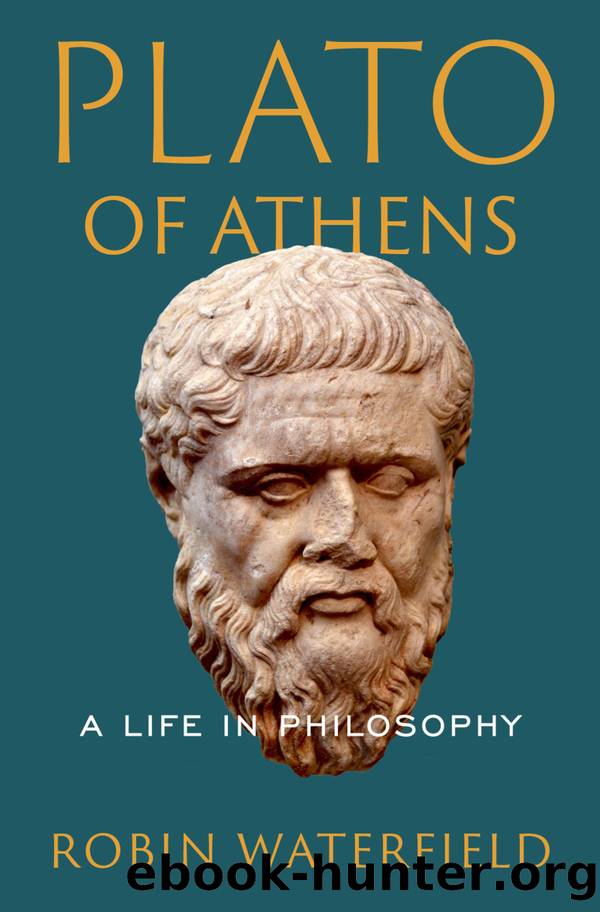Plato of Athens by Robin Waterfield;

Author:Robin Waterfield;
Language: eng
Format: epub
Publisher: Oxford University Press USA
Published: 2023-05-15T00:00:00+00:00
Figure 4.2 A silver ten-drachma piece from the time of the Syracusan tyrant Dionysius I. The head is that of Arethusa, the personification of the freshwater spring on the island of Ortygia, where Syracuse was founded.
Found in the area of Lyon; Giraud Collection, 1911.
It was especially easy to move between Locri and eastern Sicily because, though rebellion was looming, Locri was at the time part of the realm of Dionysius I, the tyrant of Syracuse and ruler of central and eastern Sicily (see figure 4.2). Dionysius had come to power in Syracuse in the last few years of the fifth century, when he was only twenty-five or so years old, and held his position until his death in 367. He was a remarkable man. He had one of the best military minds the Greeks produced; he restored Syracusan supremacy in Sicily and managed to confine the Carthaginians (originally from Carthage in what is now Tunisia), resurgent for the first time in many decades, to the west of the island,31 depriving them of much territory that they had held at the start of his tyranny; by conquest and diplomacy he developed the Syracusan empire into the most powerful state in Europe, with possessions not just in Sicily but also in the toe of Italy and up the southeastern coast of Italy in the Adriatic; he won first prize at an Athenian dramatic festival with one of his own plays (though that may be more because of the Athenian need to flatter him, rather than the excellence of the work: we cannot tell because none of his plays has survived); he had one of the longest reigns of any ancient monarch; and he managed the rare feat of dying in his bed (possibly as a result of prolonged celebration of the victory of his tragedy) rather than on the battlefield or by assassination. At the time of Platoâs visit he was preparing for war against the Carthaginians and their allies; the war ended in 375 with slight gains for the Carthaginians in Sicily, while in Italy Dionysius recovered Locri and gained the city of Croton. Taras, however, despite having been another of the Carthaginiansâ Italian allies, managed to preserve its independence by negotiating with Dionysius.
Plato tells us very little about this first visit to Syracuse, presumably because there was little to tell.32 The most important thing that happened is that he met Dion, Dionysiusâs future brother-in-law and trusted adviser (see figure 4.3). Dion, Plato assures us, was cut from a different cloth than the majority of the power possessors of Magna Graecia: he was interested in philosophy, he chose virtue over pleasure, and he wanted to convert at least some of his fellow Syracusans to the philosophical life. It was likely, given his interest in philosophy and Platoâs fame, that he had heard of the Athenian philosopher before he arrived on the island, and before long he was a convert to Platoâs way of thinking, especially about political matters. It is clear that Plato was very taken with Dion, who was aged about twenty, and saw him as an ideal student.
Download
This site does not store any files on its server. We only index and link to content provided by other sites. Please contact the content providers to delete copyright contents if any and email us, we'll remove relevant links or contents immediately.
The remains of the day by Kazuo Ishiguro(7551)
Tools of Titans by Timothy Ferriss(6947)
The Black Swan by Nassim Nicholas Taleb(6191)
Inner Engineering: A Yogi's Guide to Joy by Sadhguru(5897)
Giovanni's Room by James Baldwin(5878)
The Way of Zen by Alan W. Watts(5800)
The Six Wives Of Henry VIII (WOMEN IN HISTORY) by Fraser Antonia(4790)
The Power of Now: A Guide to Spiritual Enlightenment by Eckhart Tolle(4755)
Astrophysics for People in a Hurry by Neil DeGrasse Tyson(4620)
Asking the Right Questions: A Guide to Critical Thinking by M. Neil Browne & Stuart M. Keeley(4576)
12 Rules for Life by Jordan B. Peterson(3734)
The Ethical Slut by Janet W. Hardy(3503)
Skin in the Game by Nassim Nicholas Taleb(3460)
Housekeeping by Marilynne Robinson(3401)
The Art of Happiness by The Dalai Lama(3384)
Double Down (Diary of a Wimpy Kid Book 11) by Jeff Kinney(3272)
Skin in the Game: Hidden Asymmetries in Daily Life by Nassim Nicholas Taleb(3264)
Walking by Henry David Thoreau(3234)
12 Rules for Life: An Antidote to Chaos by Jordan B. Peterson(3201)
